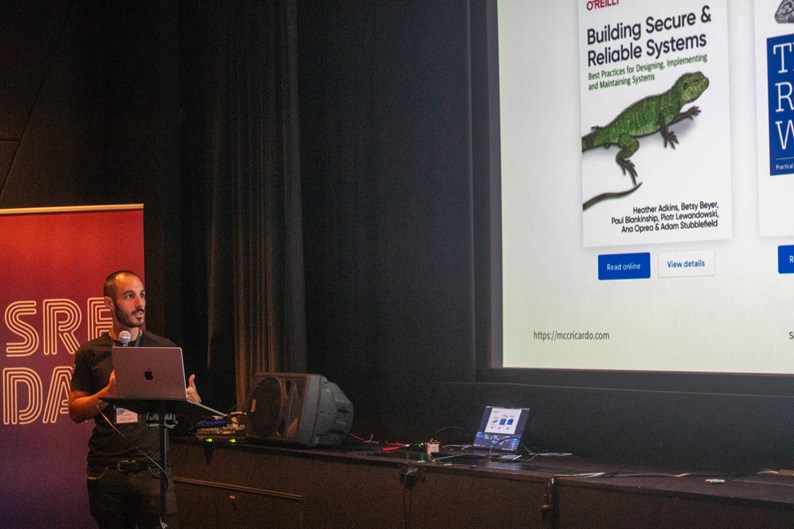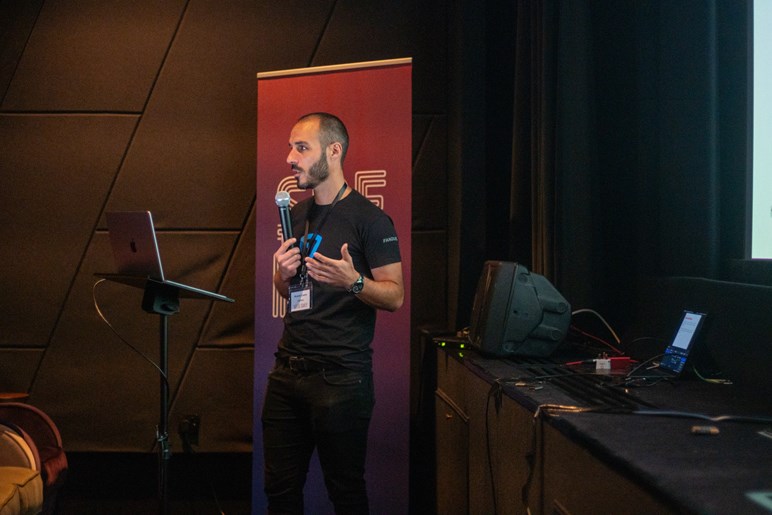Originally published on Blip.pt.
Anti-patterns can present serious difficulties in Site Reliability Engineering (SRE), where the objective is to guarantee the stability and dependability of systems. Whether ingrained in procedures, design, or culture, these anti-patterns can obstruct development, complicate reliability initiatives, and even result in system breakdowns. However, promoting sustainable operations and upholding a robust infrastructure requires an understanding of these obstacles and an effective strategy to overcome them.
Celebrating Success: Our Journey at SRE Day London 2023
It’s not only a desire, but a requirement to keep ahead of the curve in the ever-changing world of technology. Our organisation was pleased to take part in the SRE Day in September, which took place in London. The most brilliant minds in the field came together for this international event, which served as a forum for idea sharing, experience sharing, and celebration of the milestones that will influence technology’s future.
Our Principal SRE Engineer Ricardo Castro took center stage as a marker to our commitment to excellence. He gave a compelling talk that emphasised our effort to furthering the area of Site Reliability Engineering. This post will guide you through Ricardo’s talk and provide insights into the impact of our team’s commitment to this significant event and the priceless knowledge shared. Come celebrate with us as we explore the core of innovation and the progress we’re making toward building a dependable and resilient IT ecosystem. This talk describes the anti-pattern of rebranding traditional operations as “SRE.”

SRE Origin
Early in the new millennium, Google introduced SRE, which developed in response to the difficulties brought on by the company’s explosive expansion and the growing complexity IT operations. One set of engineers, Ben Treynor included, came up with the term “Site Reliability Engineering” to characterise their creative solution to the problem of maintaining high levels of performance and reliability for services like Google Search. The SRE approach, which took its cues from software engineering, aimed to combine the operational rigor of traditional IT jobs with software development skills. Through the integration of coding, automation, and continuous improvement into infrastructure management, the Google SRE team showcased the efficacy of this proactive, cooperative approach in attaining exceptional system reliability on a large scale. Because of SRE’s success at Google, the tech industry has adopted it widely throughout the years, attesting to its effectiveness in preserving high-performing, robust systems in the face of rapidly advancing technological complexity.
SRE Today
SRE is at the forefront of assuring the stability and performance of complex systems in today’s rapidly changing technological landscape. Organisations from a variety of industries are using SRE as a strategy to overcome the difficulties presented by contemporary distributed architectures, rather than merely as a collection of procedures. By emphasising automation, collaboration, and monitoring, SRE enables teams to improve and proactively manage the dependability of digital services. With companies depending more and more on microservices and cloud-based infrastructures, SRE concepts are essential for improving system performance, cutting down on downtime, and improving user experience in general.
Today, SRE is not merely a trend but a foundational element that enables companies to deliver resilient and scalable software solutions in the face of dynamic technological landscapes, demonstrating its enduring relevance and importance in the realm of contemporary IT operations.
Why SRE?
It is imperative to implement SRE techniques in the rapidly evolving technology landscape of today. By serving as a liaison between development and operations, SRE promotes a culture in software systems that places a premium on efficiency, scalability, and dependability. Businesses may minimise downtime and guarantee a flawless customer experience by adopting SRE principles, which enable them to proactively address and prevent future issues. Beyond standard IT responsibilities, SRE promotes continual improvement, automation, and monitoring to build strong, durable systems.
SRE is essentially a mindset that unites development and operations teams in pursuit of a single objective: providing dependable, high-quality services. It is not merely a methodology. As technology evolves, the need for SRE becomes increasingly apparent, empowering organisations to navigate the complexities of modern infrastructure and meet the growing expectations of users in a rapidly advancing digital era.
SRE Anti-Patterns: What and Why
SRE anti-patterns are traps or less-than-ideal SRE practices that might compromise system stability and dependability objectives. These patterns frequently appear when teams misunderstand or improperly implement SRE concepts, which can have unforeseen repercussions like higher downtime, worse performance, or wasteful resource usage.
SRE anti-patterns can include overemphasising certain indicators at the expense of overall system health, overlooking crucial monitoring components, or failing to properly prioritise error budgets. SRE teams must identify and deal with these anti-patterns to maintain alignment with the discipline’s fundamental principles and promote an adaptive and continuous improvement culture. Teams can improve their capacity to build and manage robust systems that satisfy user expectations while reducing interruptions and downtime by avoiding SRE anti-patterns.

How We Are Doing It: Avoiding and Overcoming Anti-Patterns
The FanDuel brand, part of Blip and the Flutter Group, is a big organisation with a complex environment, so it’s very important how we are approaching these changes and how we are tackling the challenges to avoid anti-patterns.
As we work to become Site Reliability Engineers (SREs), we understand how critical it is to embrace the concepts of efficiency, scalability, and reliability while also identifying and resolving any potential hazards. We are devoted to finding and addressing SRE anti-patterns in our operations as part of this revolutionary journey. Through vigilant system monitoring and performance metrics analysis, we identify potential entry points for counterproductive practices.
By taking a proactive stance, we can continuously improve our tactics and make sure that we surpass our reliability goals. Adopting a mindset of constant development, we recognise that addressing anti-patterns entails more than just making corrections—it also entails building a resilient and adaptive environment. This dedication puts us in a position to provide outstanding support and dependability in the rapidly changing world of contemporary technology.
It’s important to highlight why we are doing this: to make our engineers comfortable and our customers happy with our service. To achieve this, we are focusing on the following areas:
Incident Management
Our main goal is to prioritise incident management to prevent and resolve SRE anti-patterns. By taking early measures to avoid future problems, we hope to reduce the number of occurrences that could affect user experience and disrupt services. This strategic move reaffirms our dedication to provide dependable and robust systems while also being in line with industry best practices. Anti-patterns must be effectively managed and mitigated to reduce the frequency and severity of incidents. This proactive strategy improves our systems' overall stability and helps create a more effective incident response structure, which lowers downtime and strengthens our capacity to offer our users uninterrupted, high-quality services.
Post-mortems, also known as post-incident reviews, are the in-depth examinations carried out following an occurrence. These evaluations are essential for understanding the underlying reasons of accidents, picking up lessons from mistakes, and seeing where improvements may be made. The whole incident response team as well as occasionally other pertinent stakeholders are involved in post-mortems. The intention is to promote a culture of continual development rather than place blame.
Post-Mortems
During a post-mortem, teams review the timeline of events leading up to and during the incident, assess the effectiveness of the incident response, and identify contributing factors or anti-patterns that may have played a role. The insights gained from post-mortems inform the refinement of processes, the implementation of preventive measures, and the optimisation of systems to minimise the likelihood of similar incidents in the future. By conducting thorough post-mortems, SRE teams can iteratively enhance their incident management practices, contributing to a more resilient and reliable operational environment.
Cultivating a Culture of Collaboration
Dismantling silos and promoting information sharing and shared ownership to promote cross-functional cooperation is essential to cultivate collaboration. It is essential to adopt procedures and technologies that help teams communicate openly with one another.
Prioritising Effectively
Effective prioritising is evaluating the risk, assigning error budgets to the most important problems first, and determining how this will affect the overall dependability of the system. Teams can concentrate on the most significant anti-patterns and ensure effective and focused improvements by adopting a user-centric approach and making the most of the tools at their disposal. This prioritisation technique optimises the use of scarce resources, improves user experience, and helps avoid significant disruptions.
Comprehensive Observability
Comprehensive observability is a vital aspect of SRE, extending beyond traditional monitoring to include tracing and logging. This three-pronged approach provides SRE teams with a holistic view of system performance. Monitoring detects issues, tracing visualises request paths, and logging captures detailed event data. Together, they empower SREs to swiftly identify and address issues, fostering a culture of continuous improvement and reliability in the dynamic world of technology. Invest in robust monitoring tools and observability practices to gain deep insights into system behavior, allowing proactive responses to potential issues.
Reliability Framework
Reliability framework: It detects any problems before they become more serious through proactive monitoring. Error budgets are a notion that aids in allocating resources for countering anti-patterns. Manual error risk is decreased by automation, and failures can be learned from through post-event reviews. By encouraging teams to continuously enhance operational procedures regularly, the framework promotes a culture of continuous improvement. The overall resilience of systems is improved by cross-functional cooperation between development and operations, and by good documentation and information sharing. To put it simply, a dependability framework offers a methodical way to deal with and avoid SRE anti-patterns, making sure that systems adapt to suit shifting requirements.
Conclusion
We underwent a strategic transition in our organisational philosophy when we created a new team to focus on SRE. This change emphasised an engineering-centric and proactive approach to managing our technology infrastructure. Inspired by industry best practices modeled by digital giants such as Google, our team is now at the forefront of innovation with a renewed dedication to efficiency, scalability, and dependability. With the ability to use automation, monitoring, and teamwork, SREs can go beyond reactive operations and actively participate in the growth and improvement of our software services. This evolution ensures a more robust and responsive operational framework and puts us in a confident position to handle the challenges of today’s dynamic IT landscape. We are excited about the opportunities this change brings and look forward to a future of continued growth and excellence in Site Reliability Engineering.
Watch the full presentation here:
Written by: Soraia Gonçalves